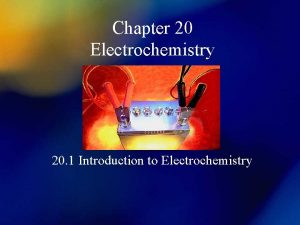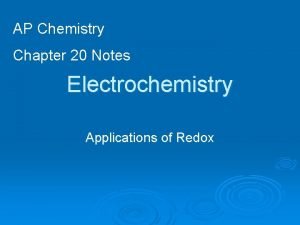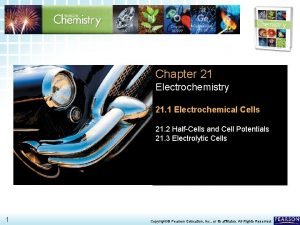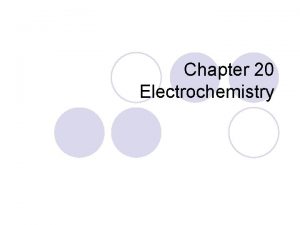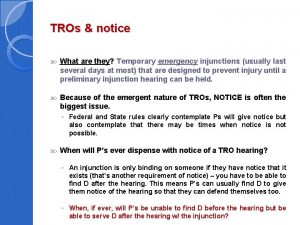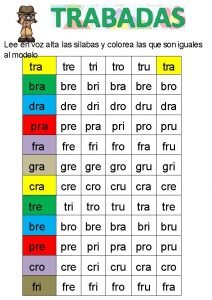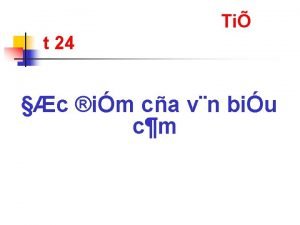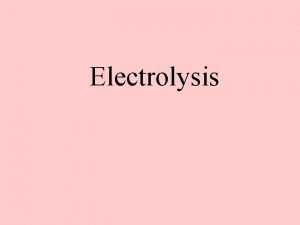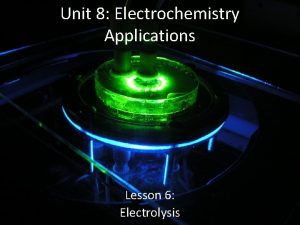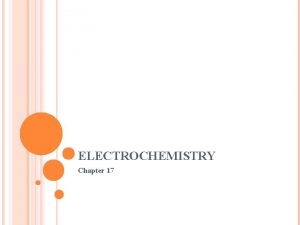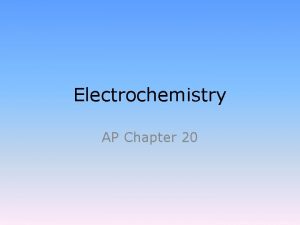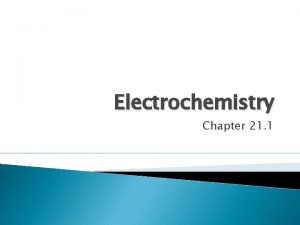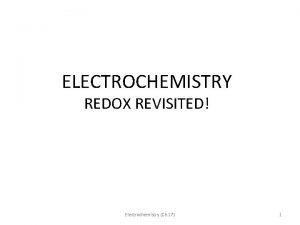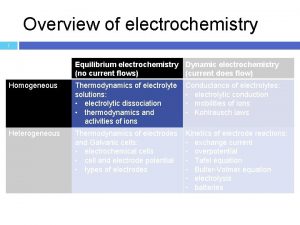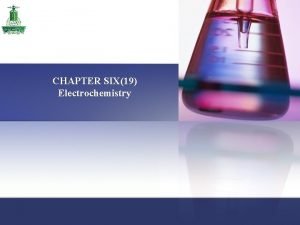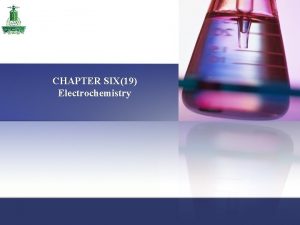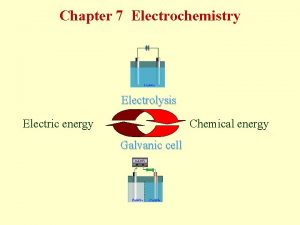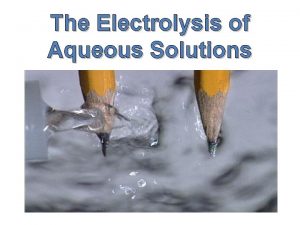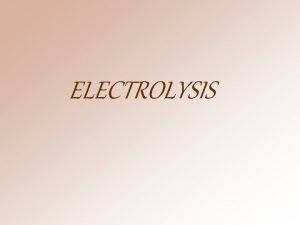Electrolysis Tro Chapter 19 Electrochemistry 19 8 Electrolysis















- Slides: 15

Electrolysis Tro Chapter 19 – Electrochemistry 19. 8 Electrolysis: Driving Nonspontaneous Chemical Reactions with Electricity

Electrochemical Cells In all cells, whether voltaic or electrolytic, oxidation occurs at the anode, and reduction occurs at the cathode. • Voltaic cells—Spontaneous reaction generates electricity. • Anode is the source of electrons and has a (−) charge. • Cathode draws electrons and has a (+) charge. • Electrolytic cells—nonspontaneous reaction driven by external electrical current. • Electrons are drawn away from the anode, which must be connected to the positive terminal of the external power source (anode +). • Electrons are forced to the cathode, which must be connected to the negative terminal of the power source (cathode -).

Electrolysis • Electrolysis is the process of using electrical current to drive nonspontaneous reaction. • Electrolysis is carried out in an electrolytic cell. • Electrolytic cells can be used to separate compounds into their elements.

Electrolysis of Aqueous Solutions • Possible cathode reactions • Reduction of cation to metal • Reduction of water to H 2 • 2 H 2 O + 2 e− ® H 2 + 2 OH− • Possible anode reactions E°= − 0. 83 V at stand. cond. E°= − 0. 41 V at p. H 7 • Oxidation of anion to element • Oxidation of H 2 O to O 2 • 2 H 2 O ® O 2 + 4 e− + 4 H+ • Oxidation of electrode E°= − 1. 23 V at stand. cond. E°= − 0. 82 V at p. H 7 • Particularly Cu • Graphite doesn’t oxidize. • Half-reactions that lead to least negative Ecell will occur. • Unless overvoltage changes the conditions

Electrolysis of Na. I(aq) with Inert Electrodes Possible oxidations 2 I − → I 2 + 2 e − Eoox = − 0. 54 V 2 H 2 O → O 2 + 4 e − + 4 H+ Eoox = − 0. 82 V Oxidation with the more positive Eoox occurs (most negative Eored) Possible reductions Na+ + 1 e− → Na 0 Eored = − 2. 71 V 2 H 2 O + 2 e− → H 2 + 2 OH− Eored = − 0. 41 V Oxidation with the more positive Eored occurs I 2 + 2 e− → 2 I− Eored = +0. 54 V O 2 + 4 e − + 4 H+ → 2 H 2 O Eored = +0. 82 V Overall reaction 2 I−(aq) + 2 H 2 O(l) → I 2(aq) + H 2(g) + 2 OH−(aq)

Mixtures of Ions • When more than one cation is present, the cation that is easiest to reduce will be reduced first at the cathode. • Least negative or most positive E°red • When more than one anion is present, the anion that is easiest to oxidize will be oxidized first at the anode. • Least negative or most positive E°ox

If a solution contains Cu 2+, Ag+, and Zn 2+ and the voltage starts out low and is gradually turned up in which order will the metals plate? Given: Ag+ (aq) + e- Ag (s) Eored = 0. 80 V Cu 2+ (aq) + 2 e- Cu (s) Eored = 0. 34 V Zn 2+ (aq) + 2 e- Zn (s) Eored = -0. 76 V

Electrolysis of Na. Cl(l)

Production of Na

Production of Cl 2

Stoichiometry of Electrolysis • In an electrolytic cell, the amount of product made is related to the number of electrons transferred. • Essentially, the electrons are a reactant. • The number of moles of electrons that flow through the electrolytic cell depends on the current and length of time. • 1 amp = 1 coulomb of charge/second • 1 mole of e− = 96, 485 coulombs of charge • Faraday’s constant

Production of Aluminum How many kg of Al can be produced in 8. 00 hours by passing a constant current of 1. 00× 105 A through a molten mix of aluminum oxide and cryolite?

Electroplating How much time is required to deposit 5. 00 g of Ag on a tea pot using 0. 100 A? How much copper can plate out when 10. 0 amps (1 A = 1 C/s) of current is used over a 30. 0 minute period through a solution of 1. 00 M cupric ions (cupric sulfate solution) with a power source greater than 1. 10 V? Cu (s) + Zn 2+ (aq) Zn (s) + Cu 2+ (aq) Tro, Chemistry: A Molecular Approach 13

Electrorefining

Challenge Question To electrodeposit all of the Cu and Cd from a solution of Cu. SO 4 and Cd. SO 4 required 1. 20 F of electricity (1 F = 1 mol e-). The mixture of Cu and Cd that was deposited had a mass of 50. 36 g. What mass of Cd. SO 4 was present in the original mixture?
 Ap chemistry chapter 18 electrochemistry test
Ap chemistry chapter 18 electrochemistry test Intro to electrochemistry
Intro to electrochemistry Chapter 20 review electrochemistry
Chapter 20 review electrochemistry Chapter 21 electrochemistry
Chapter 21 electrochemistry Difference between galvanic cell and electrolytic cell
Difference between galvanic cell and electrolytic cell Electrons flow from anode to cathode
Electrons flow from anode to cathode Notice tro
Notice tro Silabas pra pre pri pro pru
Silabas pra pre pri pro pru Introductory chemistry 5th edition nivaldo j. tro
Introductory chemistry 5th edition nivaldo j. tro Introductory chemistry 5th edition nivaldo j. tro
Introductory chemistry 5th edition nivaldo j. tro Bài 2 cải tạo tu bổ vườn tạp
Bài 2 cải tạo tu bổ vườn tạp Hỡi người hãy nhớ mình là bụi tro
Hỡi người hãy nhớ mình là bụi tro Hãy tìm mạch ý của bài văn hoa học trò
Hãy tìm mạch ý của bài văn hoa học trò Giải phương trình bậc 1 sql
Giải phương trình bậc 1 sql Trò chơi khuông nhạc bàn tay
Trò chơi khuông nhạc bàn tay Trò chơi xem kịch câm
Trò chơi xem kịch câm

